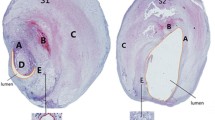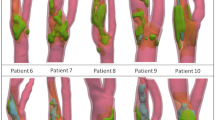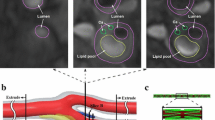Abstract
Plaque ruptures in atherosclerotic carotid arteries cause cerebral strokes. Accumulation of lipoproteins in the deep intimal layer forms a lipid core (LC), whose progression may be enhanced by mechanical conditions on the arterial wall. In this study, we investigated the pressure conditions of a liquid LC through numerical simulations of a sliced segment finite element (FE) model and a three-dimensional (3D) symmetric FE model. A model of an LC filled with nearly incompressible fluid was compared with incompressible and soft neo-Hookean LC models in a static FE analysis. Material constants for a nonlinear hyperelastic model of the arterial wall were identified based on an inflation test using a tube specimen. The results from the FE analysis of a sliced segment model show an LC fluid pressure as low as 1.9 kPa at a blood pressure of 16 kPa. A neo-Hookean LC model with a Young’s modulus of 0.06 kPa produced an almost uniform pressure in the LC within an error of 1.3 %. The 3D model predicted a similar level of LC pressure. Such low fluid pressure in the LC region may enhance the infiltration of lipoproteins and other substances from the lumen and facilitate transport through microvessels from the adventitia to the LC.









Similar content being viewed by others
References
Falk E. Pathogenesis of atherosclerosis. J Am Coll Cardiol. 2006;47:C7–12.
Takaya N, Yuan C, Chu B, Saam T, Polissar NL, Jarvik GP, Isaac C, McDonough J, Natiello C, Small R, Ferguson MS, Hatsukami S. Presence of intraplaque hemorrhage progression of carotid atherosclerotic plaques: a high-resolution magnetic resonance imaging study. Circulation. 2005;111:2768–75.
Virmani R, Kolodgie FD, Burke AP, Finn AV, Gold HK, Tulenko TN, Wrenn SP, Narula J. Atherosclerotic plaque progression and vulnerability to rupture: angiogenesis as a source of intraplaque hemorrhage. Arterioscler Thromb Vasc Biol. 2005;25:2054–61.
Ohayon J, Finet G, Gharib AM, Herzka DA, Tracqui P, Heroux J, Rioufol G, Kotys MS, Elagha A, Pettigrew RI. Necrotic core thickness and positive arterial remodeling index: emergent biomechanical factors for evaluating the risk of plaque rupture. Am J Physiol Heart Circ Physiol. 2008;295:H717–27.
Baldewsing RA, de Korte CL, Schaar JA, Mastik F, van der Steen AFW. Finite element modeling and intravascular ultrasound elastography of vulnerable plaques: parameter variation. Ultrasonics. 2004;42:723–9.
Li ZY, Howarth S, Trivedi RA, U-King-Im JM, Graves MJ, Brown A, Wang LQ, Gillard JH. Stress analysis of carotid plaque rupture based on in vivo high resolution MRI. J Biomech. 2006;39:2611–22.
Kiousis DE, Rubinigg SF, Auer M, Holzapfel GA. A methodology to analyze changes in LC and calcification onto fibrous cap vulnerability: the human atherosclerotic carotid bifurcation as an illustratory example. J Biomech Eng. 2009;131:121002.
Tang DL, Teng ZZ, Canton G, Hatsukami TS, Dong L, Huang XY, Yuan C. Local critical stress correlates better than global maximum stress with plaque morphological features linked to atherosclerotic plaque vulnerability: an in vivo multi-patient study. Biomed Eng Online. 2009;. doi:10.1186/1475-925x-8-15.
Williamson SD, Lam Y, Younis HF, Huang H, Patel S, Kaazempur-Mofrad MR, Kamm RD. On the sensitivity of wall stresses in diseased arteries to variable material properties. J Biomech Eng. 2003;125:147–55.
Gao H, Long Q, Graves M, Gillard JH, Li ZY. Study of reproducibility of human arterial plaque reconstruction and its effects on stress analysis based on multispectral in vivo magnetic resonance imaging. J Magn Reson Imaging. 2009;30:85–93.
Yamada H, Yuri K, Sakata N. Correlation between stress/strain and the retention of lipoproteins and rupture in atheromatous plaque of the human carotid artery: finite element study. J Biomech Sci Eng. 2010;5:291–302.
Loore HM, Tobias BJ, Gibson LJ, Kamm RD, Small DM, Lee RT. Mechanical properties of model atherosclerotic lesion lipid pools. Arterioscler Thromb Vasc Biol. 1994;14:230–4.
Yamagishi T, Kato M, Koiwa Y, Omata K, Hasegawa H, Kanai H. Evaluation of plaque stabilization by fluvastatin with carotid intima-medial elasticity measured by a transcutaneous ultrasonic-based tissue characterization system. J Atheroscler Thromb. 2009;16:662–73.
Abaqus 6.9 theory manual. Dassault Systemes Simulia Corp.
SI manual for mechanical engineers, Chap. 5, JSME; 1979. p. 3 (in Japanese).
Gupta N, Bluemke DA. Progress report: MRI contrast agent and atherosclerosis. Imaging Econ. 2006. http://www.imagingeconomics.com/issues/articles/2006-11_04.asp.
Acknowledgments
This study was supported in part by a Grant-in-Aid for Scientific Research (C) from JSPS (#23560091) and a grant from Mitsui Life Social Welfare Foundation.
Author information
Authors and Affiliations
Corresponding author
About this article
Cite this article
Yamada, H., Sakata, N. Low pressure condition of a lipid core in an eccentrically developed carotid atheromatous plaque: a static finite element analysis. J Biorheol 27, 9–17 (2013). https://doi.org/10.1007/s12573-012-0051-x
Received:
Accepted:
Published:
Issue Date:
DOI: https://doi.org/10.1007/s12573-012-0051-x




